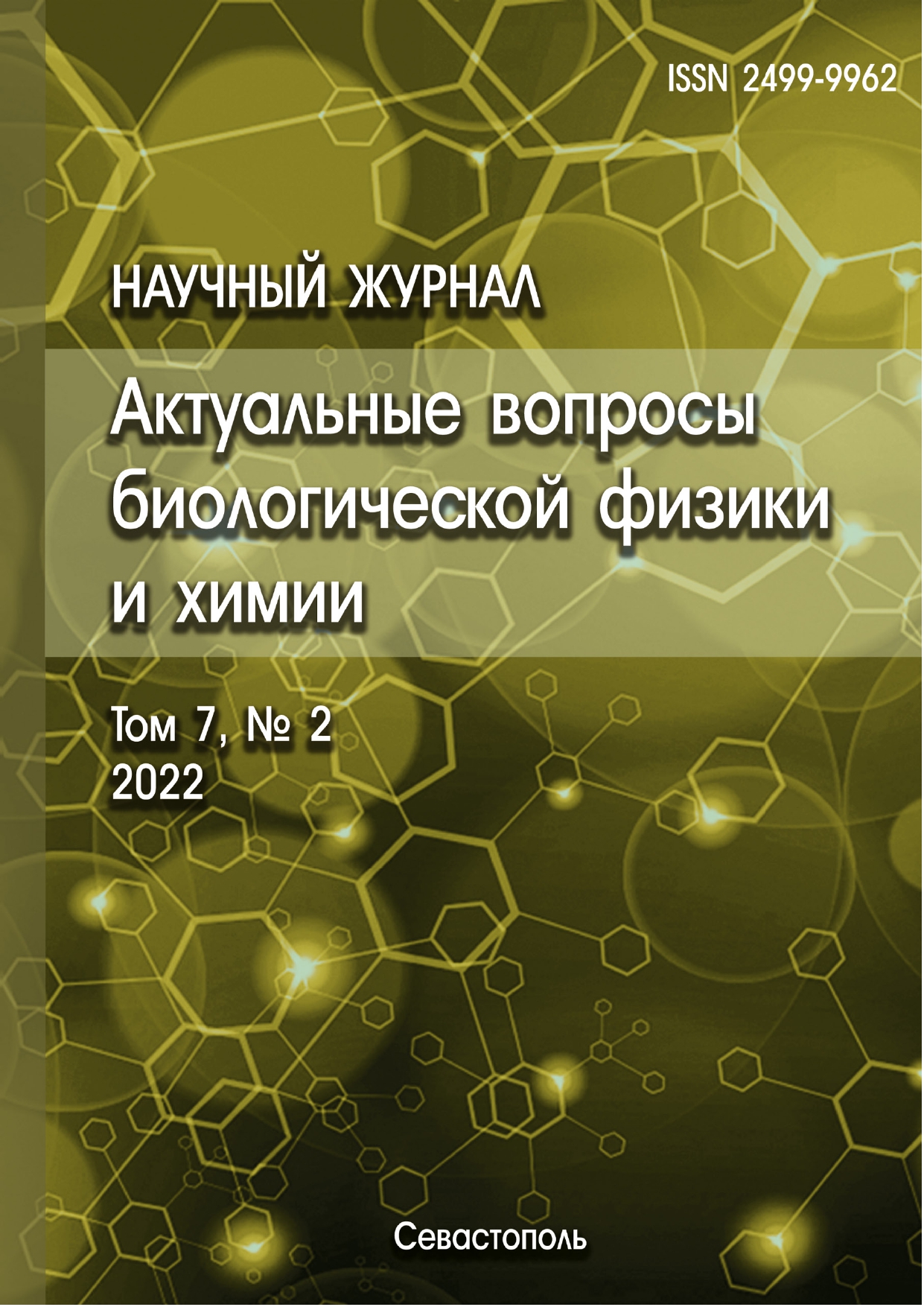Baku, Azerbaijan
Baku, Azerbaijan
The present investigation is devoted to the study of the effect of ultraviolet-B (UV-B) radiation on the survival and production of reactive oxygen species in yeast cells. It has been determined that under the action of UV-B radiation on cells, depending on its dose, the rate of oxidation of the dye 2',7'-dichlorodihydrofluorescein diacetate (H2DCF•DA) increases and a high intensity of DCF fluorescence is observed. When cells are modified with ascorbic acid before irradiation, the rate of H2DCF oxidation and the intensity of DCF fluorescence decreases. The survival rate of modified cells is increased. Ascorbic acid reduces the amount of ROS in the suspension of irradiated cells. At high doses (4.5-10 erg/mm2) of irradiation, the antioxidant effect of ascorbic acid in yeast cells is negligible. The concentration of 2-4 dinitrophenol (DNF) 10-7 M was determined as a protector, in which the substance potentially contributes to the manifestation of the effect of "soft uncoupling" in cells and, under the influence of UV-B radiation on yeast cells, helps to reduce the production of reactive oxygen species and an increase in survival. High concentrations (10–3M–10–5 M) of DNP adversely affect the survival of yeast cells and ROS production. So, it can be concluded that under the action of UV-B rays on yeast cells, antioxidants can possibly participate in the regulation of redox homeostasis.
yeast cells, survival, ultraviolet-B radiation, ascorbic acid, 2,4-dinitrophenol
1. Mittler R. ROS are good. Trends Plant Sci., 2017, vol. 22, pp. 11-19.
2. Noctor G. The metabolomics of oxidative stress. Phytochem., 2015, vol. 112, pp. 33-53. DOI: https://doi.org/10.1016/j.phytochem.2014.09.002; EDN: https://elibrary.ru/UTYRXV
3. Sies H., Berndt C., Jones D.P. Oxidative Stress. Annual Revirew of Biochemistry, 2017, vol. 86, pp. 715-748.
4. Adams L., Franco M.C., Estevez A.G. Reactive nitrogen species in cellular signaling. Experimental Biology and Medicine, 2015, vol. 240, pp. 711-717.
5. Brand M.D. Uncoupling to survive? The role of mitochondrial inefficiency in ageing. Exp. Gerontol., 2000, vol. 35, no. 6-7, pp. 811-820, doi:https://doi.org/10.1016/s0531-5565(00)00135-2. EDN: https://elibrary.ru/LPLUGB
6. Egea J., Fabregat I. European contribution to the study of ROS: a summary of the findings and prospects for the future from the COST action BM1203 (EU-ROS). Redox Biology, 2017, vol. 13, pp. 94-162. DOI: https://doi.org/10.1016/j.redox.2017.05.007; EDN: https://elibrary.ru/XNKIBM
7. Gill S.S. Tuteja Reactive oxygen species and antioxidant machinery in abiotic stress tolerance in crop plants. Plant Physiol. Biochem., 2010, vol. 48, pp. 909-930.
8. He L., He T. et al Antioxidants maintain cellular redox homeostasis by elimination of reactive oxygen species. Cellular Physiology and Biochemistry, 2017, vol. 44, pp. 532-553. DOI: https://doi.org/10.1159/000485089; EDN: https://elibrary.ru/YEYKNN
9. Herrero E. et al. Redox control and oxidative stress in yeast cells. Biochim. Biophys. Acta, 2008, vol. 1780, pp. 1217-1235.
10. Inupakutika M.A. et al The evolution of reactive oxygen species metabolism. Journal of Experimental Botany, 2016, vol. 67, pp. 5933-5943.
11. Korshunov S.S. et al High protonic potential actuates a mechanism of production of reactive oxygen species in mitochondria. FEBS Lett., 1997, vol. 416, no. 1, pp. 15-18. DOI: https://doi.org/10.1016/S0014-5793(97)01159-9; EDN: https://elibrary.ru/LEAYUZ
12. Mookerjee S.A. et al Mitochondrial uncoupling and lifespan. Mech. Ageing Dev., 2010, vol. 131, no. 7-8, pp. 463-472. DOI: https://doi.org/10.1016/j.mad.2010.03.010; EDN: https://elibrary.ru/MYBWHX
13. Niki E. Oxidative stress and antioxidants: distress or eustress? Archives of Biochemistry and Biophysics, 2016, vol. 595, pp. 19-24. DOI: https://doi.org/10.1016/j.abb.2015.11.017; EDN: https://elibrary.ru/WUOZHL
14. Noctor G. The metabolomics of oxidative stress. Phytochem., 2015, vol. 112, pp. 33-53. DOI: https://doi.org/10.1016/j.phytochem.2014.09.002; EDN: https://elibrary.ru/UTYRXV
15. Ray P.D., Huang, B.W et al Reactive oxygen species (ROS) homeostasis and redox regulation and signaling. Cell Signaling, 2012, vol. 24, pp. 981-990.
16. Kreslavskij V.D., Allahverdiev S.I. et al. Signal'naja rol' aktivnyh form kisloroda pri stresse u rastenij. Fiziologija rastenij, 2012, vol. 59, no. 2, pp. 163-178. (In Russ.) EDN: https://elibrary.ru/OWEOSH
17. Ursini F., Maiorino M., Forman H.J. Redox homeostasis: the golden mean of healthy living. Redox Biology, 2016, vol. 8, pp. 205-215. DOI: https://doi.org/10.1016/j.redox.2016.01.010; EDN: https://elibrary.ru/XMOJLF
18. Sekova V.Ju. et al. Okislitel'no-vosstanovitel'nyj status jekstremofil'nyh drozhzhej Yarrowia lipolytica pri adaptacii k rN-stressu. Prikladnaja bioh. i mikrobiol., 2015, vol. 51, no. 6, pp. 570-577. (In Russ.)
19. Sharma P., Sharma P., Reactive oxygen species, oxidative damage, and antioxidative defense mechanism in plants under stressful conditions. J. Bot., 2012, art. id 217037, pp. 1-26, doi:https://doi.org/10.1155/2012/217037.
20. Reczek C.R., Chandel N.S. ROS-dependent signal transduction. Current Opinion in Cell Biology, 2015, vol. 33, pp. 8-13.
21. Suzuki N., Suzuki N., Koussevitzky S. ROS and redox signalling in the response of plants to abiotic stress. Plant Cell Environ, 2012, vol. 35, no. 2, pp. 259-270.
22. Frajkin G.Ja. Molekuljarnye mehanizmy destruktivnyh, zashhitnyh i reguljatornyh fotobiologicheskih processov. monogr. Frajkin G. Ja.; M:000 “AR-konsalt”, 2016, 88 p. (In Russ.) EDN: https://elibrary.ru/XGQWMZ
23. Podal'ko V.I. Vlijanie 2,4-dinitrofenola na intensivnost' okislitel'nyh processov v pecheni krys v dlitel'nom jeksperimente. Uspehi gerontalogii, 2010, vol. 23, no. 1, pp. 98-103. (In Russ.)
24. Starkov A.A. Mild uncoupling of mitochondria. Bioscience Rep., 1997, vol. 17, no. 3, pp. 273-279. DOI: https://doi.org/10.1023/A:1027380527769; EDN: https://elibrary.ru/LELTVN
25. Morgunova G.V., Karmushakov A.F. et al. Izuchenie vlijanija «mjagkogo razobshhenija»2,4-dinitrofenolom na rost posledujushhuju gibel' v stacionarnoj faze kul'tury kletok kitajskogo homjachka. Vestn. Mosk. Un-Ta. ser. 16. Biologija, 2019, vol. 74, no. 3, pp. 207-214. (In Russ.) EDN: https://elibrary.ru/JQQGSO
26. Gummatova S.T., Kocharli N.K. et al. Vlijanie 2,4-dinitrofenola na intensivnost' msek-ZJeS AO v kletkah drozhzhej. Fundamental'nye issledovanija, 2011, no. 11, pp. 590-593. (In Russ.) EDN: https://elibrary.ru/OUKVGN










